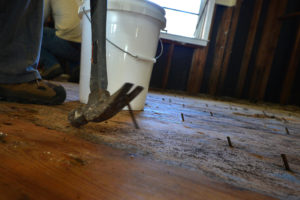Mold on Subfloor in Kitchen
If you have mold on the subfloor in your kitchen, we suggest that you call today to speak with an expert. Allowing the mold to stay there can cause damage to your property and health.

Is Mold Dangerous?
The extent to which mold can cause health issues depends on a variety of factors, including:
- The type of mold that is present
- How sensitive a particular individual is to the mold
- The amount of mold present
Common Health Issues Caused by Mold
Mold can cause a wide variety of health problems, but the most common include:
- Allergy symptoms
- Brain fog
- Low energy
Needless to say, if you think that there may be mold in your property, it is a good idea to call a professional as soon as possible.
What Types of Mold Are Found in Buildings?
Different types of mold carry varying health risks. The severity of these different mold types typically depends on the levels of mycotoxins released into the atmosphere. Here are a few types of mold that are regularly found in buildings:
Alternaria
This type of mold is known to cause allergic reactions due to its large spores. It is most commonly found on or near carpets and textiles.
Aspergillus
Aspergillus releases a relatively high amount of mycotoxins compared to other types of mold, so you should be extra careful with it if it is found in your property. It is typically found in warmer climates, around moisture and dust.
Cladosporium
This type of mold is usually found outdoors, but the spores can make their way inside through the HVAC system. Cladosporium typically grows on clothing and textiles.
Stachybotrys
This type of mold is commonly referred to as black mold and can cause many health issues. Although it is not found as regularly as some types of mold, it can be found almost anywhere in a property that has moisture, including on kitchen subfloors.
Where Does Mold Commonly Grow?
Mold can be found almost anywhere in a property that has a food source and a moisture source. It also prefers places with little air circulation and temperatures around 70-90 degrees Fahrenheit. Some places where these conditions often occur are:
- Crawl spaces
- Attics
- Basements
- Bathrooms
- Kitchens (including the subfloor of the kitchen)
Kitchen Subfloor Mold Removal Process
Although it is possible for you to preform small remediation work on your own, we recommend calling our number for a free estimate from a professional. If the work is done incorrectly, the mold can easily come back, often times to a larger extent. Here is how a professional might remediate mold:
Step 1: Create a Remediation Plan
After your mold remediation contractor takes a look at the situation, they should provide you with an approximate outline of the processes they need to take. It is a good idea to submit this plan along with any other necessary documents to your insurance company to try and get the work covered.
Step 2: Remove Your Belongings
Mold can easily spread to the belongings in the affected areas, so it is important to remove your personal belongings as soon as possible. Another reason this is a good idea is to make room for the professionals to demolish the mold damaged area.
Step 3: Set up HEPA filters
HEPA filters can help to remove mold spores from the air and prevent the mold from spreading to other parts of your property.
Step 4: Take a Look at What Is Causing the Moisture
Since mold needs moisture to grow, your restoration contractor should find the moisture source and fix it. They will generally use a moisture meter to get this part done.
Step 5: Block off the Area
Professionals can use polyethylene sheeting to block off the area of your property that has been contaminated with mold, stopping the mold from spreading.
Step 6: Remove the Area with Mold Damage
Your restoration contractor can now demolish the mold damaged areas and dispose of the debris in polyethylene bags. It is a good idea to also double bag the building materials and clean the outside of the bags to lower the risk of contamination.
Step 7: Clean
After the mold contaminated building materials are removed, it is time to clean the remains. To do this, professionals typically use a wire brush and disposable wipes. After the wipes are used, they should be properly disposed of by using the same double bagging method applied for removing the mold damaged building materials.
Step 8: Drying
In order to dry the water damage, your contractor can use specialized fans and dehumidifiers. They should also monitor this equipment over time and make changes until the building is dried to a safe level.
Step 9: Construction
Now that the area is properly decontaminated, your contractor can begin to reconstruct the places that they demolished during the mold remediation process. Although not all restoration service providers offer reconstruction, they should be able to point you in the direction of someone who does.
Step 10: Personal Belonging Put Back
The final step in the restoration process is to deal with your personal belongings. Some items can be cleaned and put back, but some items may be totaled and are lost forever. For these lost items, you or your contractor should document them and request a payout from your insurance company.
Reduce the Chances of Having the Mold Return
Here are some precautions that you can take to reduce the chances of having mold come back:
- Check for leaks and water damage
- Waterproof your property
- Maintain your roof and gutters
- Use an air purifier to reduce the spores in the air
- Keep your building ventilated
Speak with a Pro
If you have mold on the subfloor in your kitchen or anywhere else, call today to speak with a professional for free!